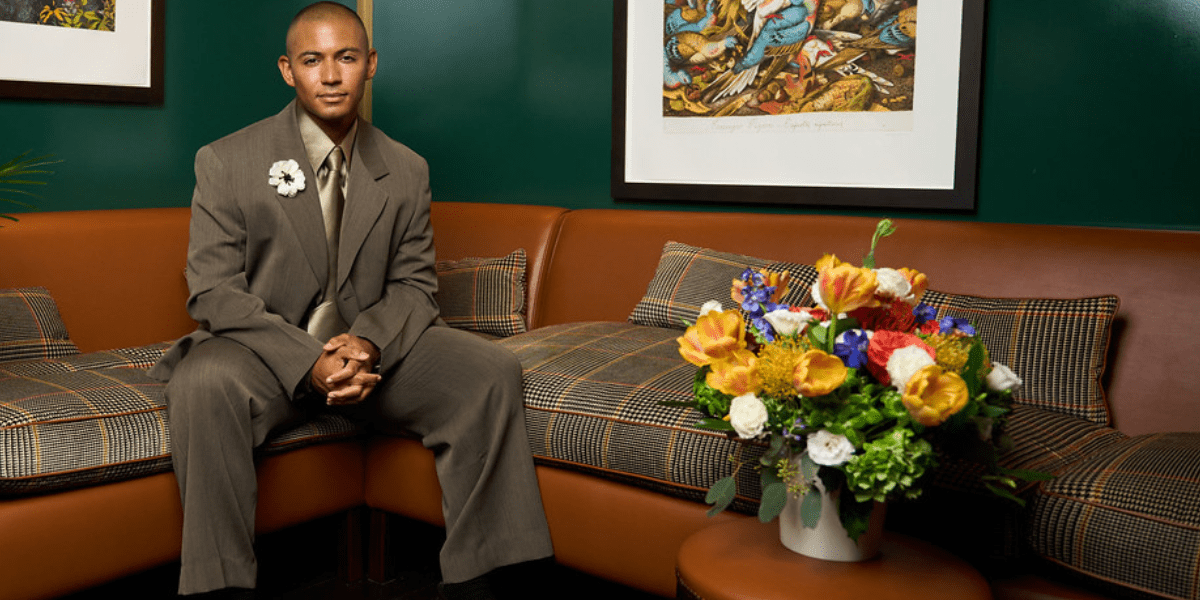
feature image photo of Zach Stafford by Daniel Vasquez via Native Son
If Dandyism is the practice of self refinement through the curation of fashion and apparel, then Black Dandyism is the utilization of fashion and apparel to express and communicate one’s own agency and independence. Whether that be to persuade those in power by the emulation of them, or, to define oneself, according to your own terms, The Black Dandy knows that there can never be enough beauty. He acknowledges the famine for beauty in the world, and decides to fulfill it, through his own personal need and desire to adorn oneself with fashion.
It was the late fashion editor, André Leon Talley, who brought the Black Dandy to life. It was he who first planted the seeds for this year’s Met Gala, “Superfine: Tailoring Black Style”, during his tenure at Vogue. Andrew Bolton, head curator at Metropolitan Museum of Art’s Costume Institute, found Slaves to Fashion: Black Dandyism and the Styling of Black Diasporic Identity, Dr. Monica L. Miller’s book that inspired this year’s Met Gala, shortly after the passing of André Leon Talley. He describes his death as “the catalyst for the show” in this morning’s press preview for the fashion exhibition.
The icon, who passed in 2022, is surely walking the halls of the Metropolitan Museum of Art, in preparation for the Met Gala. It is his spirit that many Black fashion designers and stylists will call upon on the big day. And the sweet irony of that. The man, who was once referred to as Queen Kong, is now the patron saint of the Met Gala. A Dandy indeed.
In this Q&A, we speak with Zach Stafford about his relationship to The Black Dandy, red carpet coverage, and the significance of Black fashion being on display for the world to see at this year’s Met Gala.
Taylor Crumpton: The ongoing conversations around this year’s Met Gala is that a lot of Black designers and fashion houses that historically haven’t been invited in the past now have a seat at the table. How do you feel about the framing of this year’s Met Gala, which appears to be a heralding of diversity, but, it does feel afterwards, let’s go back to the ways of the past?
Zach Stafford: Yeah, that is true. You know Telfar will probably be there. Pyer Moss, probably won’t anymore, but so many Black designers, I could go down the list of them, are gonna be dressing, be present and may now be collected inside the Met. It is sad that they have not always been collected by the Met, that it does require an event of this scale for the Metropolitan Museum of Art to say maybe we missed some things.
I think Monica Miller who wrote Slaves of Fashion has helped them with the correcting of this issue as they’ve been building out the collection and taking in things. I bet they’ve had a lot of the clothing we’re gonna see. I think it’s just been deep in their archives. They’ve never done an exhibition like this. To your point, this is the first time clothing’s either being collected or being showcased after being hidden for so long, which is sad because Black culture has shaped all the Mets before.
I said that today when I was at Vogue, to the editors. I don’t think Black people have been waiting for this Met Gala at all. We for one thought it would never happen, and then two got real used to being like, we don’t need that.
We have our own stuff. We have our own ways of celebrating. In New York, Harlem Fashion Week is the big Black fashion week moment every year that operates outside of New York fashion week. We have our spaces. We have our people. Dapper Dan wasn’t crying that he wasn’t getting invited. We survive. We push through. I think with this Met, it is an opportunity for people to finally honor the fact that we have shaped all of the Met galas in the past.
Rihanna is the biggest star that walks the carpet. Always has been. She’s a Black woman. Tyla wore sand last year. It stopped everything. She’s a Black woman from the continent of Africa. We always knew we were the best. Now everyone’s gonna see the best altogether. I think it’s a moment for us to really celebrate the ancestors that got us here.
People like WEB Du Bois or James Baldwin, who were dandies, who were using fashion to help elevate the other work they were doing. That’s also the history of the Dandy. Dandyism is a way of taking up space. I think your [TIME] piece hit on that too, where it’s about taking up space, showcasing fashions and interesting things, but it’s really a moment of being like you kidnapped us from Africa, threw us into this country, gave us scraps and we had to make something beautiful out of it and look what we’ve made.
I think the history of Blackness in America, that’s existed for 400 plus years, is always beating below us. We’ve become very used to telling that story to each other and now to the world. I don’t think we were ever waiting for the Met to tell that story. I said that to Chioma [Nnadi] today, Head of Editorial Content of British Vogue, it kind of feels like now you’re getting it.
We’ve always been here and been doing this. The point is a lot of the Black designers who are not being collected all worked for the biggest [fashion] houses. Whether it’s Michael Kors, Chanel, Bottega Veneta, but they just weren’t celebrated.
I think Monday will be the celebration of those names that you may not have realized were shaping the fashion that you’ve been wearing for decades.
Taylor: On Monday, you will be following in the footsteps of André Leon Talley by covering the red carpet for them, in the spirit and tradition of his poignant fashion critique. How are you preparing for Met Gala coverage?
Zach: Oh my God. I have no idea what to expect because my position on the carpet is a collaboration between Vibe Check and Condé Nast. The day of, we’ll be with them. I think Teen Vogue as well, but mostly them, which is the queer [Condé Nast] publication.
I’ll have people stopping and talking to me. The thing I’ve been told over and over is, the guests are walking the carpet without their teams or publicists. It’s extremely overwhelming. I’ve never been before. It’ll be my first time, but they’ll kind of be left with their own devices.
We’ll see who walks over to do the conversation. I’ve even heard it in the past, André was so good at his job, because he demanded a seat at the top of the steps, and before people walked in he called them over. The best red carpet hostess ever, Keke Palmer, she called them in. I’ve been told because there’s so much going on. The press are on both sides. Cameras are on every side. It’s a lot. As I prepare for what I am bringing to the table for this, I’m really interested in the stories.
People are gonna be sharing the whys around why they picked it. For me, it’s not just tied to the theme, but I think we’re gonna see a lot of people mixing in pieces from their own archives or their family’s archives. I’ve heard a lot about vintage being pulled. When I say vintage, I’m not meaning mugler archives. I mean like people being like, there’s a brooch my grandmother used to wear to Sunday service. I’m gonna wear that brooch.
I think that’s gonna be really interesting, if that does happen, to where people are gonna be thinking about their own past, present, and futures, because Blackness exists in all timeframes at all times. Saint Laurent has been doing zoot suits this past year on the runways, but those come from the early 1900s. I think there’s gonna be this moment of time travel that’s happening for folks. They’re gonna have accessories and garments that really show that.
It feels different than when Kim Kardashian wore Marilyn Monroe’s dress; that felt very camp and that was interesting. That was a lot of other things about wealth and access. This is kind of a homegoing of some sorts. We’re needing to finally be able to say the names, to your point, of everyone that led us to this moment.
Not just the Andrés, but everyone else that has not been talked about enough. I hope in my red carpet coverage, I’m thinking of the diaspora, of ourselves in fashion, [of the] stories people are telling. I’m very interested in making sure Black queer people are celebrated because dandies are also coded as queer. Whether queer as in, they have sex with men or queer as in they just sit outside normativity.
Dandyism is to me forever queer. When LeBron James started wearing his dandified Thom Browne to NBA games, it was a queer moment. He’s carrying a bag. It’s queer-coded and has a queer sensibility. I’m excited because of the work we do on Vibe Check, my own work as a journalist, and just a person that thinks about the world. I’m excited that I will be very unapologetic about that queer history that will be displayed and be able to have the language to contextualize it in real time, where like my colleagues at other major broadcast outlets may not be able to catch certain things.



The MetGala is currently going on as I’m typing this and one thing I am noticing is that a majority of the white celebrities didn’t even try to stay on theme and it is pissing me off. Why even go if you were just going to be disrespectful to all your black peers who are making an effort? Yeah, I know the obvious answer is that they just to say that they went to a Met Gala but something tells me if it had been any other year they would have at least tried. It’s like all they heard was “black” and just decided wear anything in that color and didn’t even engage with the rest of the theme. Some of the women couldn’t even be bothered with even that much. Just put on a ball gown and called it a day.
Doğayı seven, kuşları tanımak isteyen veya üretim konusunda kendini geliştirmek isteyen herkes için serinofil.com bir başvuru kaynağı niteliğinde.
Just finally getting to this but I’m so excited to read this this interview Zach Stafford – Vibe Check is one of my favorite podcasts.
Had filed this for ages but this is such a good and interesting article!
I agree with Turkish above it felt like some white celebs just tried less than even usual! and many people normally don’t hit (“looking camp right in the eye”) but like….c’mon. Make an effort! It’s rude!